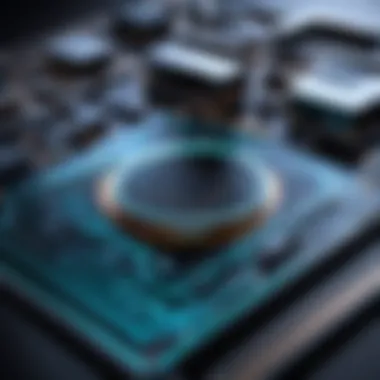Understanding DXF Drawing Programs: A Comprehensive Overview


Intro
DXF drawing programs are fundamental in the realm of technical drawing and design. The Drawing Exchange Format (DXF) was developed by Autodesk to facilitate data interchange between their software and others. These programs play a crucial role in various industries including architecture, engineering, and manufacturing. They serve as a bridge, allowing users to create, modify, and interact with complex design files.
This article delves deep into the world of DXF drawing programs. It will highlight their key features, functionalities, and applications in different sectors. Additionally, a comparison with other drawing formats will provide a clearer perspective on where DXF stands in the landscape of design tools.
Understanding the capabilities and limitations of DXF drawing programs can significantly enhance one's design workflow. This overview will serve as a comprehensive guide, catering to individuals interested in optimizing their use of these tools in a modern technical environment.
Prolusion to DXF Drawing Programs
The realm of technical design and drafting has evolved significantly due to advancements in technology. DXF drawing programs play a vital role in this progression. They enable designers and engineers to create intricate drawings with precision and clarity. Understanding DXF is essential, as it connects various disciplines, making it possible to share and collaborate on designs seamlessly.
Definition of DXF Format
DXF, or Drawing Exchange Format, is a file format developed by Autodesk. It serves as a medium for enabling data interoperability between various CAD programs. The core purpose of the DXF format is to facilitate the exchange of drawings and design data between different applications. The structure of DXF files includes both 2D and 3D data, allowing for diverse uses in varied industries. Understanding how DXF functions assists users in leveraging its potential within design workflows, particularly when multiple software platforms are involved.
History and Development
The DXF format was introduced in 1982, alongside the first version of AutoCAD. The intention was to create a solution to the compatibility issues that existed between different drawing software. As CAD systems grew more sophisticated, the DXF format was revised to accommodate new features. Over the years, many updates have been made, keeping pace with the needs of users and advances in technology. This historical context highlights the importance of DXF drawing programs, not only as tools for creation but as crucial players in the evolution of design technology. With the ongoing development, the relevance of DXF remains strong in today's design-driven industries.
Key Features of DXF Drawing Programs
In understanding DXF drawing programs, it is essential to examine the key features that make these tools valuable for designers, engineers, and architects. These programs are increasingly popular due to their efficiency in producing precise drawings and simplifying design workflows. Important elements to consider include file compatibility, editing capabilities, and layer management. Each feature serves to enhance functionality and adaptability, which are crucial in technical drawing.
File Compatibility
File compatibility is a fundamental aspect of DXF drawing programs. DXF, which stands for Drawing Exchange Format, was developed by Autodesk to enable seamless data sharing between various CAD applications. This improves collaboration among users, as drawings can be easily transferred between different software.
For example, files created in AutoCAD can be efficiently shared with users of other software like DraftSight and FreeCAD without loss of data integrity. The widespread adoption of the DXF format across the industry means that professionals can work with different programs without fearing incompatibility issues. Being able to open and save DXF files encourages flexibility in project teams, making it a preferred choice among those who need to work in a multi-platform environment.
Editing Capabilities
The editing capabilities of DXF drawing programs are another critical feature. These programs provide a variety of editing tools that allow users to manipulate designs with precision. Users can easily modify shapes, adjust dimensions, and alter line types. Moreover, many DXF programs support commands that enable advanced editing features, such as copying, mirroring, or rotating objects to create complex designs effortlessly.
Additionally, these editing tools often come with undo/redo functionalities, allowing users to experiment freely without fear of making irreversible mistakes. The ability to refine designs quickly saves time and improves overall workflow efficiency. Overall, the strong focus on editing in DXF drawing programs caters to the user’s need for accuracy and flexibility.
Layer Management
Layer management is a vital feature of DXF drawing programs. It enables users to organize different elements of their design effectively. Layers can be used to separate various components of a project, such as annotations, dimensions, and graphical representations. This organization enhances clarity, especially in complex drawings where many elements coexist.
Users can control visibility and properties of each layer independently, which allows for streamlined editing. For example, one can focus solely on electrical layouts while hiding architectural elements. This prevents confusion and allows a cleaner workspace. The layer system helps to maintain accuracy, as modifications to one part of a drawing do not inadvertently affect others.
"Layer management in DXF drawing programs is more than just organizing elements; it is about creating clarity and focus in technical drawings."
Industries Utilizing DXF Drawing Programs
The relevance of DXF drawing programs transcends beyond mere technical drawing; various industries leverage these tools to enhance their design and production processes. The versatility of the DXF format allows different sectors to utilize its capabilities effectively, leading to improved accuracy, consistency, and collaboration in projects. Understanding how industries apply these programs provides insight into their necessity and benefits in real-world applications.
Architectural Design
In the architectural field, DXF files serve as a fundamental format for drafting blueprints and construction plans. Architects rely on the precision of DXF to communicate ideas clearly and effectively with clients and contractors. The flexibility of the DXF format supports the integration of layers for various design aspects, such as electrical layouts, plumbing, and structural details. This organization allows for easier adjustments and modifications, which is crucial during the design phase. Furthermore, many architectural design software like AutoCAD and ArchiCAD support DXF, enabling a seamless exchange of information between different applications.


Manufacturing and Engineering
DXF drawing programs play a pivotal role in manufacturing and engineering sectors by facilitating computer-aided design (CAD) processes. Engineers use DXF files to create detailed models and technical drawings for production. These drawings often include information necessary for CNC machining and other automated processes. Having an industry-standard file format like DXF helps ensure that specifications are met consistently. Additionally, project collaboration becomes smoother, as manufacturers can easily share and interpret these files across various machines and software, thus streamlining production activities.
Graphic Design
In graphic design, DXF files are not limited to technical drawings; they extend into the realm of vector graphics. Designers appreciate the detail and scalability offered by DXF for creating intricate patterns or illustrations. While it may not be as commonly used as formats like SVG for web-based designs, its integration into software like Adobe Illustrator allows graphic designers to incorporate DXF files in their workflows. The ability to import and export DXF within these design tools enables the integration of technical and artistic elements, enhancing creativity while maintaining precision in design.
"Different industries utilize DXF drawing programs to achieve superior detail, compatibility, and efficiency in their projects."
Through these examples, it is clear that DXF drawing programs are not just limited to one sector. Each industry derives distinct advantages from utilizing this format, highlighting its significance across diverse applications.
Comparative Analysis of DXF with Other Formats
In the realm of technical drawings and design, it is essential to understand how DXF interacts with other file formats. This analysis sheds light on the differences and similarities with common alternatives like DWG, STL, and PDF. By examining these relationships, users can make informed decisions on which format suits their needs best. The comparative analysis not only highlights the unique features of DXF but also emphasizes its interoperability and efficiency in various scenarios.
DXF vs. DWG
DXF and DWG are closely related formats frequently used in computer-aided design (CAD). Both were developed by Autodesk, but they serve different purposes. While DWG serves primarily as a native file format for AutoCAD and other Autodesk applications, DXF stands for Drawing Exchange Format, which allows for data interoperability between different CAD applications.
One major difference lies in data storage. DWG files can contain rich data, including 3D models and metadata, making them more complex and often suitable for intricate designs. In contrast, DXF files are simpler in structure and typically focus on 2D data representation, which may lead to less precision in some 3D applications.
Consider the following points when choosing between DXF and DWG:
- Compatibility: DXF is ideal for seamless sharing between different software applications, whereas DWG is more suited for specialized tasks within Autodesk products.
- File Size: DXF files tend to be smaller due to their less complex data, which can facilitate quicker transmission and loading times.
- Feature Set: If advanced features are necessary, DWG may provide enhanced capabilities, particularly in 3D detailing.
DXF vs. STL
The comparison between DXF and STL formats reveals a stark contrast in focus and application. STL, or Standard Tessellation Language, is mainly used for 3D printing and modeling. It represents surfaces of 3D objects using triangular facets. On the other hand, DXF focuses primarily on 2D vector graphics and can also support 3D data, but not in the same detailed and triangle-based manner as STL.
Key differences include:
- Purpose: DXF is more suitable for technical drawings, while STL specializes in producing printable 3D models.
- Data Structure: DXF includes various geometric shapes and annotations, making it versatile for design purposes. In contrast, STL simplifies geometry into triangles, which may not always accurately represent intricate designs.
- Editing Capability: DXF allows for ease of editing in CAD software due to its vector nature, whereas STL files can be more challenging to modify after creation.
DXF vs. PDF
The relationship between DXF and PDF is important to understand, especially in the sharing and presentation of designs. While the PDF format is often used for document sharing and printing, it also has capabilities for handling vector graphics. FXF stands out for its design-oriented features that allow for more interactive usage in CAD environments.
Some considerations when comparing DXF and PDF include:
- Interactivity: DXF files can be easily edited and modified within CAD software, providing real-time adjustments. PDFs act as static documents and are less flexible for further alterations.
- Presentation: PDF files are ideal for sharing completed designs, offering a familiar format for clients and stakeholders who may not use CAD software. DXF is better for sending files for collaboration or subsequent editing.
- File Integrity: DXF maintains data integrity and fidelity in technical drawings, while PDFs sometimes risk losing precise measurements due to conversion processes.
The choice of file format is critical. Understanding the strengths and weaknesses of DXF in relation to other formats can significantly improve workflow efficiency.
Advantages of Using DXF Drawing Programs
DXF drawing programs provide a range of advantages that make them indispensable in various fields of design and engineering. These programs allow users to create, modify, and share technical drawings with ease, which is particularly important in industries where precision and detail are paramount. Companies and professionals must understand these advantages in order to leverage the full potential of DXF programs in their workflows.
Versatility and Interoperability
One significant advantage of DXF drawing programs is their versatility and interoperability. DXF file format is broadly recognized and compatible with a wide variety of CAD software and other design applications. For example, users can export a drawing created in AutoCAD directly into a DXF format and subsequently import it into a different program like SolidWorks or SketchUp without losing essential data. This flexibility is crucial for teams working across different platforms or disciplines.


Additionally, the DXF format accommodates 2D and 3D designs, enabling users to utilize a single format for various types of projects. The option to incorporate numerous layers within a single drawing allows for organized and comprehensive design management. This facilitates collaboration and streamlines the integration of various elements, such as dimensions and annotations, which can be crucial for complex projects.
High Precision and Detail
Another important aspect is the high precision and detail that DXF drawing programs can provide. In technical and engineering designs, the accuracy of measurements and representations is vital. DXF files preserve geometrical data with exceptional fidelity, ensuring that designs retain their intended specifications when shared or edited.
This precision extends to various elements of design, including curves, shapes, and dimensions. For industries such as architecture, where meticulous detail is necessary for structural integrity, being able to create and manipulate designs at a high resolution is a significant advantage. Moreover, many DXF programs offer advanced tools to refine details, such as snapping features for precise alignment and editing functions that maintain the integrity of the drawing.
"The ability to maintain detail and precision in designs is non-negotiable in technical fields; DXF programs deliver this through robust formatting capabilities."
In summary, the advantages of using DXF drawing programs lie in their versatility, interoperability, and ability to render high precision in design work. These attributes empower professionals to optimize their workflows, facilitating seamless collaboration without compromising on quality or accuracy.
Limitations of DXF Drawing Programs
While DXF drawing programs serve crucial roles in design and engineering, they are not without limitations. Understanding these restrictions is vital for users who rely on DXF files for accurate and effective workflows. Addressing these challenges can help users make informed decisions when choosing design software and manage expectations regarding the DXF format.
File Size and Complexity
One significant limitation of DXF drawing programs is related to file size and complexity. As designs grow in complexity, the resulting DXF files can become quite large. Larger files may lead to slower processing times and may even cause some software to crash, especially in less powerful machines. This can hinder productivity and frustrate users who need to open or manipulate large files quickly.
Furthermore, the intricate nature of detailed designs in DXF files means they may not retain the same level of efficiency as simpler formats. Users often find that while DXF can store a considerable amount of information, the program's responsiveness tends to diminish with increasing complexity. Consequently, there is a trade-off between detailed representation and operational efficiency.
"As designs get more detailed and comprehensive, users may struggle with the technological limitations of their chosen software, resulting in a less streamlined workflow."
Compatibility Issues
Another critical limitation involves compatibility issues. Although the DXF format is designed to be a universal file format, not all CAD software supports it at the same level. This can create challenges when transferring files between different platforms or programs. Users may face unexpected data loss or alteration when opening a DXF file in software that does not fully support all features of the DXF format.
Moreover, certain design elements may not translate properly between programs, resulting in misplaced components or altered dimensions. For firms that rely on collaboration with multiple teams using various software, these discrepancies can lead to significant headaches.
Choosing the Right DXF Drawing Software
Selecting the appropriate DXF drawing software is a decision that can significantly influence the efficiency and quality of a designer's work. Many options are available in the market, and the differences among them can be subtle yet impactful. Thus, understanding the core aspects that matter in choosing software is essential for professionals immersed in technical drawing, whether they operate in architectural design, engineering, or graphic design.
When making this choice, consider several factors, including feature sets, usability, and cost. It is crucial to evaluate how well software meets your specific requirements. The right selection will not only enhance your productivity but also ensure smooth integration into your existing workflow.
Features to Consider
When assessing DXF drawing software, several key features need attention. These features improve usability and expand the software’s capabilities.
- File Compatibility: Ensure the software can open and export DXF files without issues. Compatibility with other formats like DWG, PDF, and STL could also be beneficial, streamlining collaboration across different platforms.
- Editing Capabilities: Evaluate the editing tools present in the software. Advanced drawing, annotation, and manipulation features allow users to create detailed and precise designs efficiently.
- Layer Management: This feature is vital for organizing complex drawings. Good layer management options will help you isolate different elements and make modifications with ease.
- Customization Options: Being able to customize toolbars and shortcuts can greatly increase efficiency, especially for frequent tasks.
User Interface and Experience
An intuitive user interface can significantly affect user experience. Designers often seek software that allows for easy navigation and a smooth workflow.
- Layout: A clean, well-organized layout helps prevent confusion. Familiarity with common design software can make software with a similar interface easier to learn.
- Learning Curve: Software that is difficult to learn can hinder productivity. Look for options that provide tutorials or community support; such resources can be invaluable for mastering the software.
- Responsiveness: The responsiveness of the software when handling large and complex files is equally important. Lagging software can disrupt the design process.
Cost Considerations
Cost is an inevitable factor that shapes any decision regarding software choice. The investment in DXF drawing software varies widely, from free options to high-end professional suites.


- Budget: Determine how much you are willing to spend. Some software offers essential features that may suffice for beginners or occasional users, while advanced features might warrant a higher price for professionals.
- Licensing Model: Pay attention to whether the model is a one-time purchase, subscription-based, or cloud-based. Each model has its pros and cons depending on how frequently you plan to use the software.
- Trial Periods: Many software providers offer free trials. This can be an excellent way to evaluate the software before making a commitment. During the trial, focus on features, usability, and overall experience to ensure it meets your needs.
"The right software can transform your design process, making it more efficient and enjoyable."
Integration with Other Tools
The integration of DXF drawing programs with other software tools is crucial for enhancing the overall functionality and efficiency of design processes. As industry demands increase, the ability to sync and collaborate with diverse platforms becomes not just beneficial but essential. This integration allows users to harness the strengths of various applications, resulting in more versatile workflows and improved productivity.
CAD Software
CAD software is at the forefront of design technology. Programs like AutoCAD and DraftSight are essential for creating intricate technical drawings. Their compatibility with DXF files enables a seamless transfer of designs between different software. This compatibility ensures that details remain intact and modifications are easily manageable, preserving the high precision rates expected in technical fields.
By adopting CAD software that integrates well with DXF formats, designers can:
- Reduce Workflow Bottlenecks: Switching between multiple software can lead to errors and time waste. An optimized integration facilitates a smoother transition.
- Enhance Collaboration: Teams can work in unison, making changes in real-time without the worry of miscommunication or loss of data integrity.
- Maximize Features: Each platform has unique functionalities. Integration allows users to leverage the best tools for specific tasks, from advanced rendering in CAD to straightforward modifications in DXF editing software.
3D Modeling Tools
3D modeling tools, such as Blender and SketchUp, also present significant partnerships with DXF drawing programs. This connection is important for visualizing designs beyond two-dimensional representation. For example, converting a DXF drawing into a 3D model allows for deeper analysis and better presentation.
Some benefits of this integration include:
- Improved Design Visualization: Transforming DXF data into 3D environments enables better client understanding and engagement.
- Enhanced Analysis Capabilities: Users can inspect spatial relationships and conduct simulations that are not possible with 2D layouts alone.
- Streamlined Prototyping: When designers want to create physical models, integrating with 3D tools can facilitate rapid prototyping, increasing the speed of bringing concepts to life.
"Integration of DXF programs with CAD and 3D modeling tools significantly uplifts the design experience, combining precision and creativity."
The Future of DXF Drawing Programs
The future of DXF drawing programs is pivotal as design and manufacturing sectors evolve. DXF formats have been integral to CAD applications, and their relevance will continue with advancements in technology. By understanding forthcoming trends and innovations, professionals can stay ahead of the curve. This section explores significant emerging trends and technological innovations likely to impact DXF programs.
Emerging Trends
A few key trends are shaping the future of DXF drawing programs. First, the move towards cloud-based tools is strong. Many users are preferring to work with software that offers cloud storage and collaborative features. This eases sharing and teamwork across different geographical locations.
Second, increased focus on interoperability is happening. As businesses want to integrate diverse tools into one workflow, DXF programs are adapting. Open standards may become more prevalent, allowing seamless transitions between various design software like Autodesk AutoCAD, SketchUp, and others.
3D printing is another area seeing significant growth. As this technology advances, the need for DXF files to provide precise, high-quality models is crucial. The ability to create models that convert easily to printable formats enhances the usability of DXF programs. This change directly responds to the increasing market demand for customized products.
Technological Innovations
Technological innovations will dramatically influence DXF drawing programs. One of the forefront innovations is artificial intelligence. AI can enhance design processes, assisting designers in generating more complex and refined drawings autonomously. The integration of AI could improve not only efficiency but also the precision of the designs, which is paramount in fields like engineering and architecture.
Another innovation on the horizon is augmented reality (AR) and virtual reality (VR). These technologies allow users to visualize designs in a 3D environment. They can aid in comprehending spatial relationships and offering more immersive design experiences. For DXF drawing programs, integrating AR and VR could revolutionize how designers present their work and collaborate with clients.
The use of automation tools is also growing. Automated features can assist in repetitive tasks, allowing designers more time to focus on creativity rather than routine assignments. These tools can increase productivity and reduce human error, essential factors in high-stakes environments like construction and aerospace.
The future of DXF drawing programs reflects the dynamic needs of professionals and industries. Embracing innovations will be key to maintaining relevance and competitiveness.
The End
In wrapping up the discussion on DXF drawing programs, it is essential to emphasize their significance within various design and engineering spheres. This software serves as a bridge between creative ideas and technical execution. Throughout the article, several important elements have emerged. From understanding the DXF format to exploring its versatility in industries such as architecture, manufacturing, and graphic design, the relevance of this software becomes abundantly clear.
The advantages of DXF programs are notable. They provide high precision and detail, which are vital in technical drawings. Furthermore, users appreciate the interoperability with other design tools, making it a flexible choice for diverse applications. However, the limitations cannot be overlooked. Issues like file size and compatibility challenges deserve mention, as they can affect workflow efficiency.
"Understanding the limitations alongside the advantages of DXF drawing programs is critical for users aiming to optimize their design processes."
Summation of Key Points
- Definition and Importance: The DXF format plays a critical role in technical drawings, enabling seamless data exchange between software programs.
- Key Features: Core functionalities, such as editing capabilities and layer management, contribute to user experience and efficiency.
- Industry Applications: Various fields utilize DXF programs, showcasing versatility in architectural design, engineering, and graphic arts.
- Comparative Analysis: Understanding how DXF compares with formats like DWG, STL, and PDF is essential for informed software choice.
- Future Trends: Emerging technologies and innovations point towards a promising future for DXF drawing programs.



